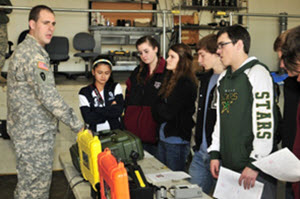Story by: Master Sgt. Daniel Griego
Posted: 15-Jan-15

|
Master Sgt. Daniel Griego
Members of the Texas National Guard's 6th Civil Support Team provide demonstrations of their procedures and equipment for chemistry students from Hill Country Christian School of Austin at Camp Mabry Jan. 15, 2015. The intent of the visit was to provide high school students with real-world applications of chemistry in the areas of emergency response and special operations. (U.S. Army National Guard photo by Master Sgt. Daniel Griego/Released)
|
AUSTIN, Texas – For the members of the Texas National Guard’s 6th Civil Support Team, community outreach is a regular part of their mission. From showcasing their capabilities at the Texas Emergency Management Conference each year to setting up a fundraising booth at the Camp Mabry American Heroes Air Show, they have a long history of meeting their neighbors while serving the state. Recently, they made a new connection in the area by inviting chemistry students from a local high school to tour their facility and learn about the real-world applications of science in responding to hazardous material incidents.
“We’re providing an opportunity that we don’t often get, to interact with high school students, more importantly, high school chemistry students,” said Lt. Col. William Phillips, commander of the 6th CST. “Hopefully, they’re going to understand that chemistry is more than just a subject by seeing the professionals who they’ve have the opportunity to interact with today who apply chemistry on a daily basis.”
The event, held Jan. 15 at the CST’s headquarters on Camp Mabry in Austin, Texas, allowed students from Hill Country Christian School of Austin to learn about hazardous compounds, try on chemical suits, and simulate testing procedures used by the CST during response operations.
“It has made me a lot more interested,” said 10th-grader Stephen Fritschle, “seeing how they do this stuff in real life and how it applies to real life. It’s actually given me a greater interest for chemistry in general and how cool it can actually be.”
The day was as much about demonstrating the value of a strong science background as it was communicating the mission of the unit. The CST, first organized in 1999, serves the state of Texas by supporting local first responders with detection, identification, and monitoring capabilities when an area is compromised by hazardous chemical, biological, radiological, nuclear, or explosive contaminants.
“There is another side of special operations that is highly trained and very specialized,” said Phillips, “and something that is not a traditional military unit’s task and purpose. That’s what the CST is, that’s what the CBRNE response enterprise is.These are Soldiers who have a very in-depth education requirement that they have to apply in hazardous environments and working in the unknown.”
Education was a recurring theme of the visit, as the Guardsmen of the CST imparted to the students the importance of academics and training in their career field.
“One of the things that is challenging as a chemistry student is understanding how the concepts that you learn in the classroom are related to real-world experience,” said Meredith Wermel, the Hill Country Christian School of Austin chemistry teacher. “So getting them to actually be able to see how some of the compounds that they’re learning about in class could be analyzed by instruments and then actually be contained is a great opportunity.”
The members of the CST were especially enthusiastic about the chance to share their mission with the next generation of scientists and service members. For some, it was the field trip they would have wanted to take in high school.
“I wish I had this opportunity when I was at LBJ,” said Staff Sgt. Carolina Dilger, a survey team member with the 6th CST. “My military career absolutely would have started here.”
The CST plans to conduct more tours like this in the future as they continue their efforts to support and educate the community.
“I feel like I have a deeper understanding. I love seeing how it is applied,” said 10th-grader Emma Astad. “I’m really happy I came.”